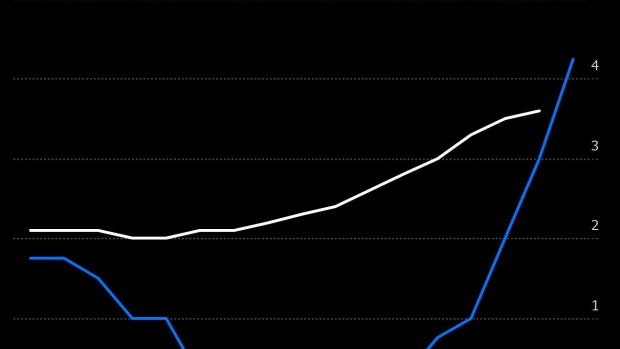Nov 27, 2022
RBNZ Surprised by Persistent Inflation, Assistant Governor Says
, Bloomberg News

(Bloomberg) -- New Zealand’s central bank has been surprised by the strength of inflation, which has boosted price expectations and required a more aggressive interest-rate response, Assistant Governor Karen Silk said.
“What we have seen is actual inflation continue to surprise on the upside, but more importantly inflation expectations have moved higher as well,” Silk said in an interview with Bloomberg Monday in Wellington. “And it’s the persistence factor that has probably been the most surprising.”
The Reserve Bank last week raised the Official Cash Rate by 75 basis points to 4.25% -- the biggest increase since the OCR was introduced in 1999 -- and projected the benchmark will need to reach 5.5% next year to return inflation to its 1-3% target. The RBNZ’s move to accelerate tightening comes as some other central banks look to slow their rate increases as risks mount of a global recession.
Silk, who joined the central bank’s Monetary Policy Committee in May, said the RBNZ hadn’t been too slow to tighten, even though some of its global peers have been raising rates in 75-point increments for some time.
“Obviously we started way earlier than other central banks, so other central banks had to move an awful lot faster basically to play catch up,” she said. “So no, I don’t believe that the MPC has dilly-dallied around on this at all.”
The RBNZ last week published a new estimate of the short-run, nominal neutral OCR, which showed it has risen to 3.6%. That means the RBNZ has only now achieved restrictive policy by lifting the benchmark above that level.
“So that’s sitting higher, which means that actually your financial conditions are more accommodative than you would’ve thought,” Silk said. “Therefore you need higher interest rates.”
The RBNZ’s forecasts show inflation accelerating to 7.5% in the current quarter from 7.2% in the three months through September -- a projection that is higher than those of most other bank economists.
Silk said a key element of the central bank’s new inflation outlook was a surprisingly strong increase in food prices in October.
Asked if the RBNZ could stop short of taking the OCR to 5.5%, Silk said the bank would need to see inflation receding and a subsequent decline in inflation expectations.
“If the information shows that we’ve reached that peak and we see that turn and we’re starting to see real impacts on inflation and inflation expectations, then that does offer us the opportunity to revisit,” she said.
At the same time, the RBNZ has built into its forecasts the lagged impact of its tightening to date, including the many households that still need to refinance mortgages at higher interest rates, she said.
Silk, a former general manager at Westpac New Zealand, said the recession the central bank is forecasting for next year would be shallow as the economy was starting from a strong position.
She said a higher exchange rate would be “helpful from an inflation perspective” but was not something the RBNZ was aiming for when it decided to increase the pace of its tightening.
Silk also said a monthly inflation report from Statistics New Zealand “would be good.”
(Updates with comment on neutral OCR.)
©2022 Bloomberg L.P.






